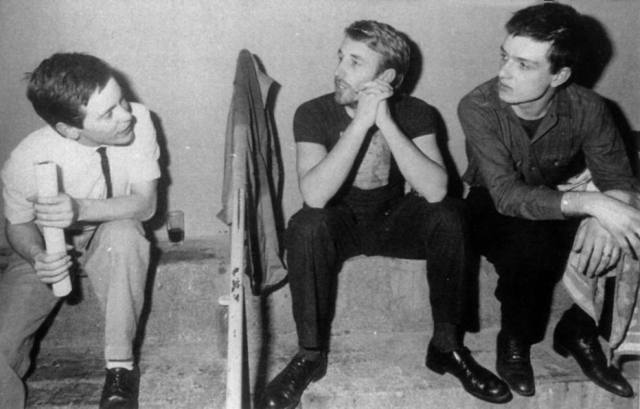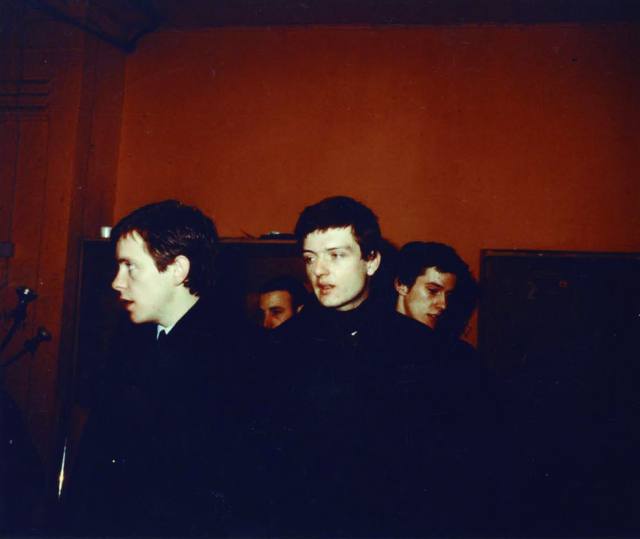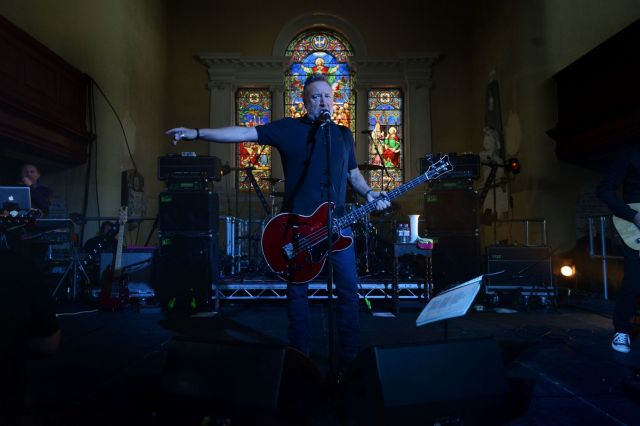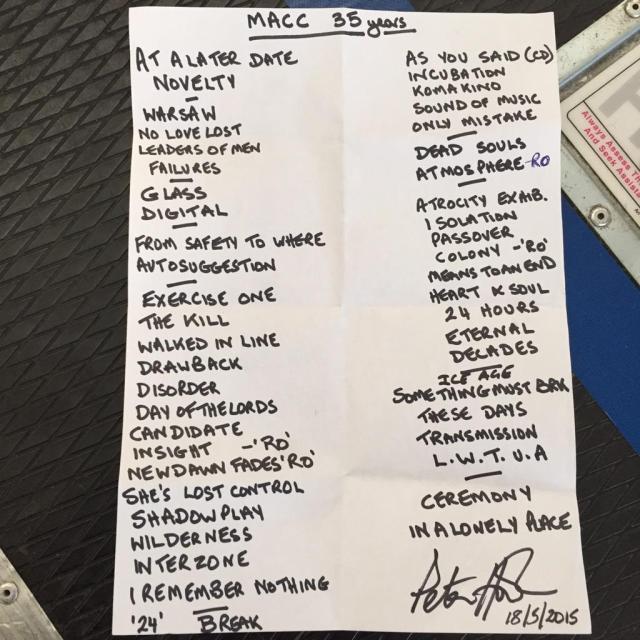To mark the recent 35th anniversary of the death of Ian Curtis, here’s a classic interview with Joy Division, first published in Sounds in November 1978, and taken from Rock’s Backpages, the online home of music writing

THROB, THROB, THROB, THROB. “Hey Miss, a bottle of Newcastle please. What? Oh, a bottle of Pils, then.” THROB, THROB, THROB, THROB.
The small, underage boy is becoming frustrated. All around him drinks and money are changing hands. Louder, deeper voices continually overwhelm his feeble pleadings. Even when he finds a chance to speak out on his own, the throbbing of the music succeeds in drowning his words.
Forty feet behind him a group are on stage. The bass player has his back to the audience; he is swaying from side to side with the doomy rhythm. The lead guitarist stands dead still at the back; next to him two drumsticks hammer into the shivering drum-kit. At the front of the stage the lead vocalist stands with his right hand waving about in epileptic fashion. He is screaming infectious vocals: “Seen the real atrocities buried in the sand, stockpiled safety for a few, while we stand holding hands…”
The name of the band is Joy Division. A doomy, Mancunian four-piece who emerged in early 77 under the name of Warsaw. It is Friday night/Saturday morning inside Manchester’s energetic Russell Club, and the crowd are politely non-committal. They seem mainly concerned with the traditional Friday night pastime of becoming outrageously drunk and are not taking much interest in the band. The band themselves are well below par and cannot reach the high standard that is their usual boast. Three weeks ago they achieved the impossible when they received a standing ovation from the normally ultra-passive Band on the Wall audience. Tonight, the finish is anticlimactic. They began in fine form but the set slowly tapers off to a mediocre finish. I stagger out of the club greedily clutching my free copy of the band’s 12-inch single and, in true Springsteen style, I speed off into the night, maaan.

The next morning arrives too soon. I crawl out of bed with a dull throbbing at the back of my head and intent on self-mutilation, I reach for the record deck. Joy Division’s EP is cruelly slapped on. I flinch as the static clicks in the speakers and await my fate. The music begins, dark and loud, almost early Black Sabbath. The lyrics cut through my head.
Advertisement
“I was there in the backstage, when the first light came around, / I grew up like a changeling to win the first time around, / I can see all the weakness, I can pick all the faults. / But I concede all the faith tests just stick in your throats…”
I’ve never, in all my record-collecting life, known a record that is produced as loud as this. The second track is loud but experimental. Hard to compare it to anybody but perhaps Wire. It is magnificent in every way and I couldn’t be more sincere. The EP is called An Ideal For Living and is available now on Anonymous Records in 12in form. It was out earlier in the year as a 7in but the record’s power was missing. This is, as they say, the real thing.
Thirty hours later I walk nervously into the room marked Rehearsal Room Number Six and mentally study the lads who are huddled in the far corner. They are Joy Division plus manager Rob Gretton. I am trying to assemble a decent set of questions in my head. The room is freezing and the atmosphere is equally icy. I sit on the filthy floor and gather the band’s names. They are: Ian Curtis – vocals, Bernard Albrecht – guitar, Pete Hook (Hookey) – bass, and Steve Morris (who looks like John Maher) – drums.
After some five minutes of non-communication we decide to move to the pub, where the ice is broken. Only Pete Hook seems unconcerned to the point of total indifference. He curls up in the chair next to mine and verges on the unconscious. I try to ignore him and begin the strange interview.
On the record label it says “songs by Joy Division”. Do you write collectively? Who comes up with the ideas?
Ian Curtis: “It varies a lot, musically anyway.”
Bernard: “We usually start with a drum riff and then add bass and guitar on top of that. Ian supplies the lyrics.”
Ian: “Yeah, I’ve got a little book full of lyrics and I just fit something in. I have a lot of lyrics in reserve so I’ll use them when the right tune comes along. The lines are usually made up of all sorts of odd bits. Leaders of Men, for example – some of the lines are two or three years old.”
What are the lyrics about?
Ian: “I don’t write about anything in particular, I write very subconsciously.”
Steve Morris: “If they were about anything specific they would become dated.”
Ian: “Yeah, I leave it open to interpretation.”
Are they trying to hide something, I think to myself as I drop the all-time clanger.
When everyone thinks of Joy Division they automatically think of this Nazi thing. Perhaps it’s because of your previous name (Warsaw). What have you to say about that?
Bernard: “We picked Warsaw simply because it is a very nothing sort of name. We didn’t wish to be called ‘the’ somebody.”
Rob Gretton: “Back to this Nazi thing. It’s good if people can jump to conclusions. I think that people can be very naive sometimes.”
Bernard: “People tend to take a radical viewpoint on everything, whereas if they would just think for a change they would see that it was absolutely nothing.”
Rob: “You wrote in your review that ‘Joy Division still persist in this Nazi-history chic’. What does that mean?”
It’s a feeling that circulates around your audience, plus the way you look on stage. (Incidentally, does Ian Curtis shout “Have you all forgotten Rudolph Hess?” at the start of the Joy Division track on the Electric Circus album?)
Rob: “They may look dark and mysterious on stage, but why do people connect that with the Nazis?”
Ian: “Everyone calls us Nazis.”
No, I didn’t say that you were Nazis. I said that you seemed to be interested in Nazi history.
They Walked In Line (Ian Curtis, 1978): “All dressed up in uniforms so fine, / they drank and killed to pass the time. / Wearing the shame of all their crime, / With measured steps they walked in line…”
Bernard: “Everyone says that, but compared to Jimmy Pursey, who was an out-and-out racist…”
Why?
Bernard: “Well, you don’t think so, that proves my point. Nobody can remember the beginning of Sham 69 and the things he said then. Now he tries to disconnect himself from his past. Still, his lyrics are great.” (General laughter).
Have you played in London at all?
Rob: “No, never. It’s been a conscious thing, really, we want to wait for a while until we have more things on record. Actually, there could well be something in the near future, but I can’t go into that.”
Would it be fair to suggest that you are as near to heavy metal as you are to new wave?
Rob: “I really couldn’t say, but we are the only band in Manchester who have not turned towards pop. Would you agree?”
What about the Fall?
Rob: “Oh, yeah I forgot them.”
Ian: “Do you like the Fall?”
Yeah, my favourite band, in fact.
Rob: “Really, I dunno about them. They are like us in one respect because they don’t pamper the audience. I don’t see why you should pamper the audience.”
The interview ends. I exchange “see yous” with them and leave the pub. I am happy, I even stop to pat the dog that is guarding the pub’s entrance before I cross the road. I am happy because Joy Division are one of the leading bands in the current renaissance of Mancunian activity. Manchester may have died during the last summer but right at this moment it is preparing for the second assault.
© Mick Middles & Sounds











